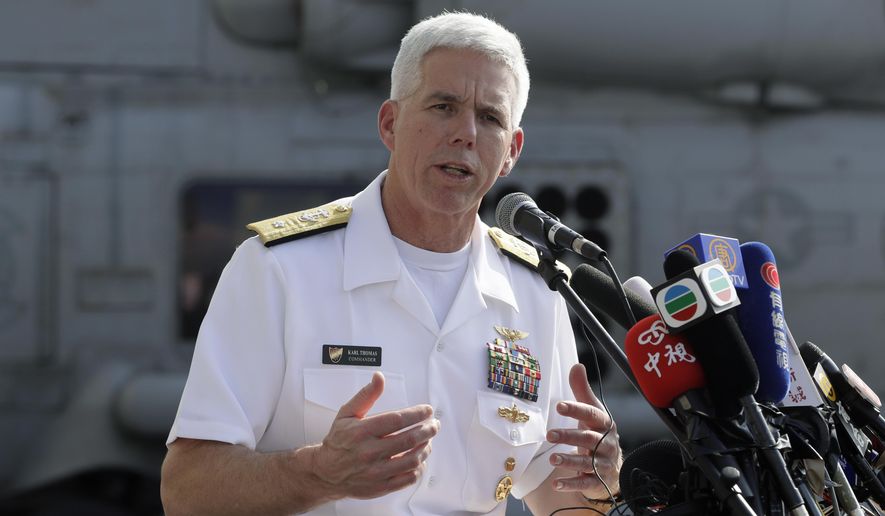China now boasts a large navy with enough surface warships to blockade rival Taiwan, according to the commander of the U.S. Navy‘s frontline fleet.
“They have a very large navy, and if they want to bully and put ships around Taiwan, they very much can do that,” Vice Adm. Karl Thomas, commander of the U.S. Seventh Fleet, said in an interview with The Wall Street Journal.
China‘s People’s Liberation Army conducted large-scale naval maneuvers around Taiwan last month in what defense analysts say was practice for future military action against the island state Beijing claims as its territory.
The war games followed the visit to Taiwan by House Speaker Nancy Pelosi that Beijing said violated U.S.-China understandings about the status of the island state.
Since early August, China has stepped up military provocations around Taiwan with at least five warships encircling the island and multiple, daily air defense zone intrusions by its warplanes.
President Biden said during a broadcast interview Sunday that the United States would intervene to defend Taiwan against a military attack from China.
SEE ALSO: Biden says U.S. officers will defend Taiwan if China invades
Asked if U.S. military forces would be sent to defend the island, Mr. Biden told CBS’ “60 Minutes”: “Yes, if in fact there was an unprecedented attack.”
The White House later said the comments did not reflect a new U.S. policy toward the defense of Taiwan. Long-standing U.S. policy has been called “strategic ambiguity” — not stating clearly how the United States would respond to a Chinese attack. However, Mr. Biden’s repeated statements clearly stating the U.S. military would defend the island — even as his aides try to walk them back — indicates a policy shift.
The governments of Japan and Australia also recently let it be known unofficially they would join a U.S. military defense of Taiwan.
For U.S. military planners, the challenge now is to define what constitutes what Mr. Biden called an “unprecedented attack” that would trigger U.S. military intervention.
Adm. Thomas, the Seventh Fleet commander, said he does not know if China will use its military against Taiwan. But he said his forces must be ready for any eventuality.
“Clearly if they do something that’s non-kinetic, which, you know, a blockade is less kinetic, then that allows the international community to weigh in and to work together on how we’re going to solve that challenge,” Adm. Thomas said.
Two commanders of the Hawaii-based Indo-Pacific Command have said in recent congressional testimony that China‘s military is set to attempt a takeover of the island in the next few years.
The three-star admiral also disclosed that U.S. military aircraft that transported Mrs. Pelosi to Taiwan used special tactics amid concerns the Chinese military might threaten the speaker’s aircraft. The military plane flew a circuitous route to reach the island instead of flying over the disputed South China Sea, where China has deployed anti-aircraft missiles on reclaimed islands.
Senior U.S. officials decided to take the precaution, Adm. Thomas said.
“There certainly was a lot of rhetoric by the PRC about, if she goes, there will be some consequences,” he said, using the acronym for People’s Republic of China. “You never quite know with the PRC if the rhetoric is real or if it’s just that — rhetoric — and just to prevent any miscalculation, there were some decisions made to give us a little bit more time and space to understand what their reaction might be.”
News reports in Asia said U.S. fighter jets escorted the C-17 transport used to ferry Mrs. Pelosi and several other members of Congress to the visit that began Aug. 2.
Adm. Thomas said the Chinese military’s firing of nearly a dozen missiles during the post-visit war games had “moved the goalposts just a little bit more” in upsetting the fragile status quo.
“There’s a term in Mandarin: ‘can shi’ — nibbling like a silkworm,” he said. “They just kind of continue to push the boundaries, see what they can get away with.”
Adm. Thomas said China has “completely militarized” disputed islands in the South China Sea that it has occupied. Defense officials have said the islands in both the northern and southern parts of the South China Sea have been equipped with anti-ship and anti-aircraft missiles and electronic warfare equipment.
“They already have all the bunkers they need, they already have all the fuel storage capacity they need, the ability to house troops, they have the missiles, the radars, the sensors,” he said.
Adm. Thomas said China has also surpassed the U.S. Navy numerically, rapidly fielding large numbers of Type 055 guided-missile destroyers. A recent Congressional Research Service report stated that China now has 355 warships, and plans to have 420 ships by 2025 and 460 ships by 2030.
The current deployable U.S. Navy warship force includes 298 battle force ships, including 11 aircraft carriers and 49 nuclear attack submarines.
China also is bolstering its capabilities for conducting joint warfare — combining naval, air, and army forces in a conflict, a U.S. military specialty.
“They are more ‘joint’ than they were a year ago, three years ago, five years ago,” Adm. Thomas said.
In a related development, a Navy guided-missile destroyer and Canadian frigate sailed through the Taiwan Strait on Tuesday in a regular freedom-of-navigation operation, said Navy spokesman Lt. Mark Langford.
“The ships transited through a corridor in the strait that is beyond the territorial sea of any coastal state,” he said in a statement.
The warships were identified as the USS Higgins and the HMCS Vancouver.
The transit “demonstrates the commitment of the United States and our allies and partners to a free and open Indo-Pacific,” Lt. Langford stated.
• Bill Gertz can be reached at bgertz@washingtontimes.com.




Please read our comment policy before commenting.